A Report on Leadership, Training & Talent Management at the NHS
VerifiedAdded on 2023/04/23
|14
|3386
|301
Report
AI Summary
This report provides an in-depth analysis of human resource management (HRM) within the National Health Service (NHS) in the United Kingdom, focusing on three key areas: leadership and management, training and development, and talent management. It examines the differences between leaders and managers, explores various management styles and leadership traits, and assesses the role of NHS management and the HR function in supporting leadership. The report also evaluates the benefits of training and development for both the organization and its staff, identifies training needs, and discusses evaluation tools used in the training process. Furthermore, it delves into talent management strategies, highlighting the differences between traditional employment focuses and talent management approaches. Internal and external influences on these three areas are analyzed using SWOT and PESTLE frameworks, providing recommendations for improvement in each area to enhance organizational effectiveness and employee performance. The report concludes by emphasizing the importance of strategic HRM practices for achieving competitive advantage and maximizing employee potential within the NHS.
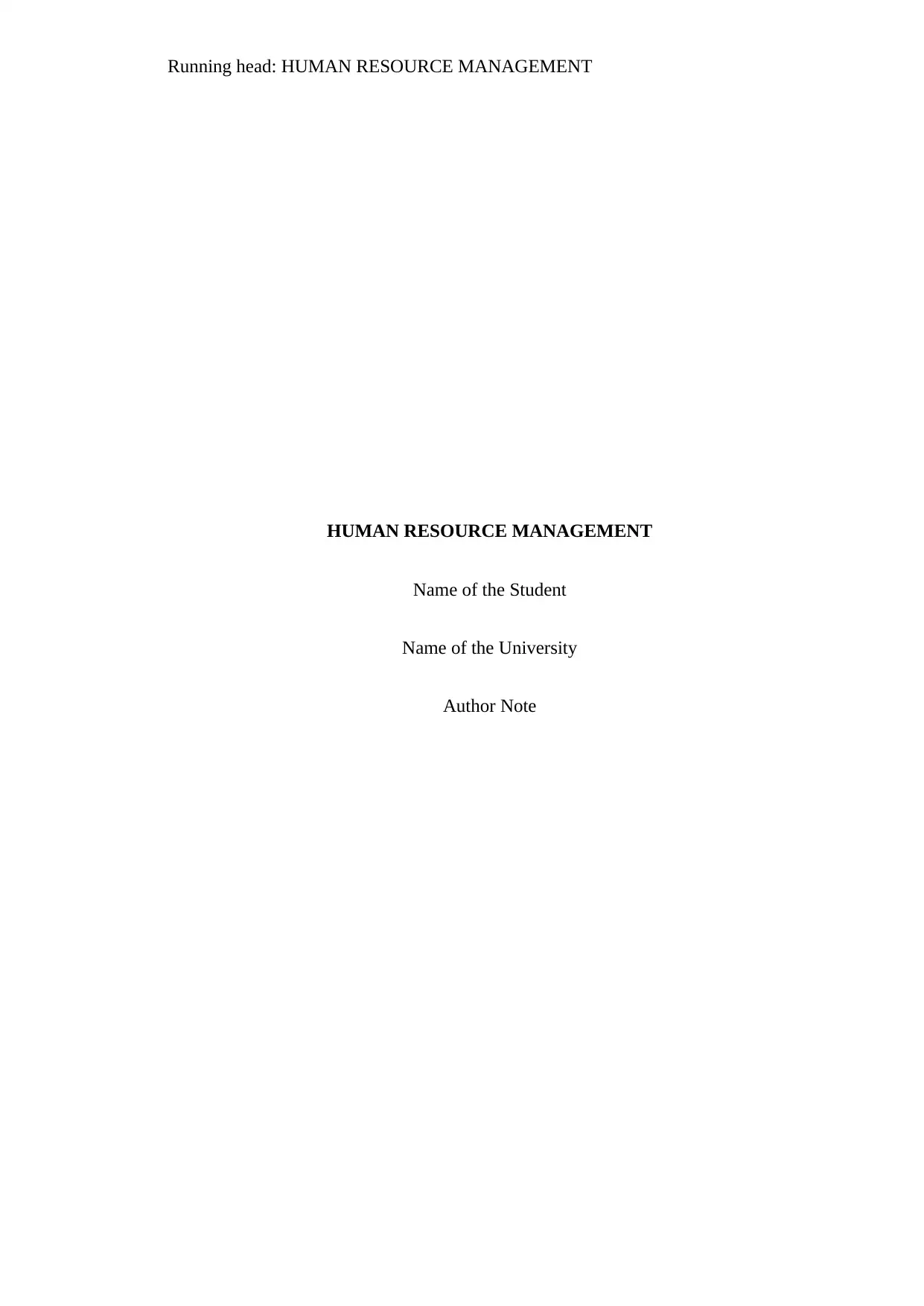
Running head: HUMAN RESOURCE MANAGEMENT
HUMAN RESOURCE MANAGEMENT
Name of the Student
Name of the University
Author Note
HUMAN RESOURCE MANAGEMENT
Name of the Student
Name of the University
Author Note
Paraphrase This Document
Need a fresh take? Get an instant paraphrase of this document with our AI Paraphraser
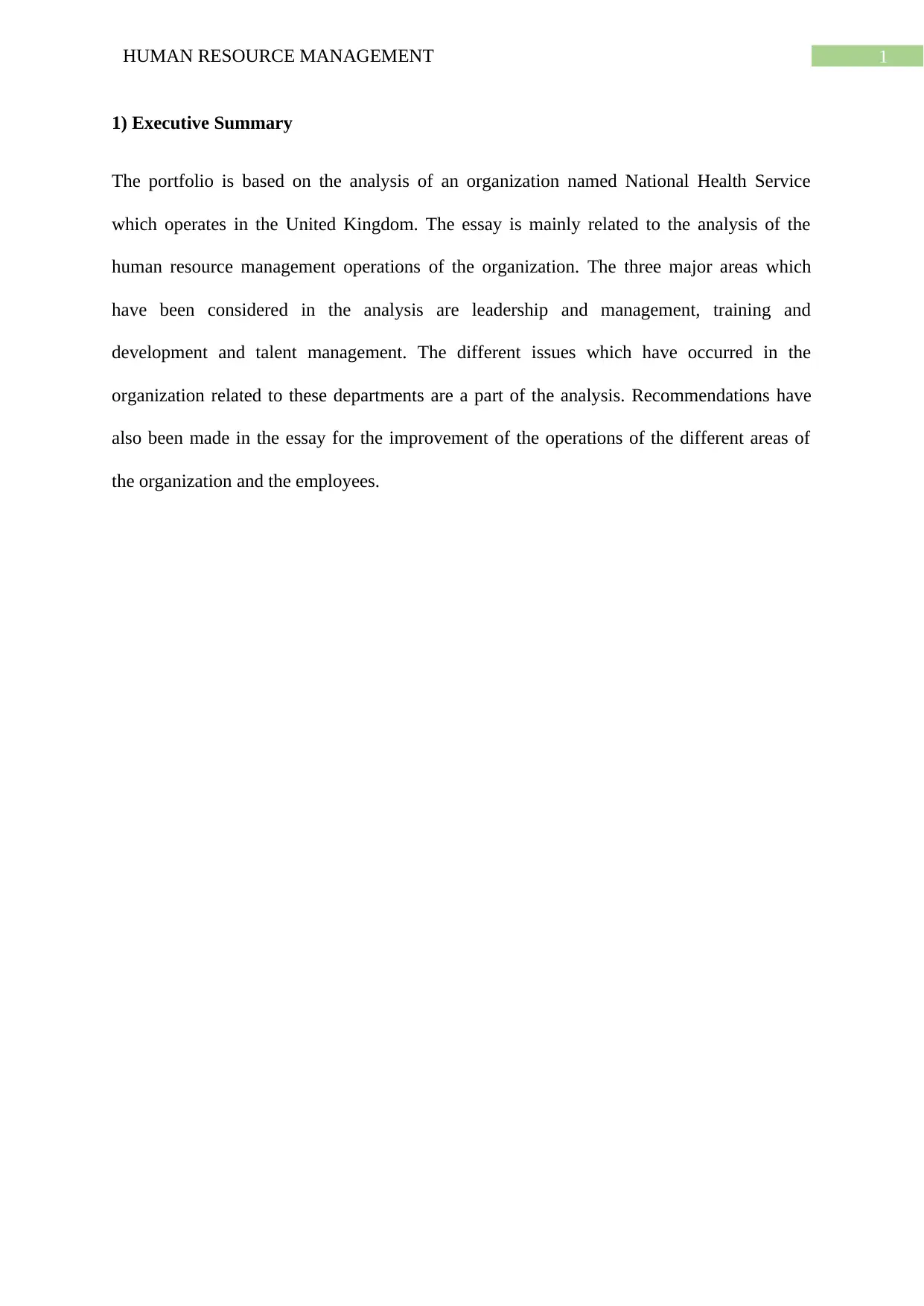
1HUMAN RESOURCE MANAGEMENT
1) Executive Summary
The portfolio is based on the analysis of an organization named National Health Service
which operates in the United Kingdom. The essay is mainly related to the analysis of the
human resource management operations of the organization. The three major areas which
have been considered in the analysis are leadership and management, training and
development and talent management. The different issues which have occurred in the
organization related to these departments are a part of the analysis. Recommendations have
also been made in the essay for the improvement of the operations of the different areas of
the organization and the employees.
1) Executive Summary
The portfolio is based on the analysis of an organization named National Health Service
which operates in the United Kingdom. The essay is mainly related to the analysis of the
human resource management operations of the organization. The three major areas which
have been considered in the analysis are leadership and management, training and
development and talent management. The different issues which have occurred in the
organization related to these departments are a part of the analysis. Recommendations have
also been made in the essay for the improvement of the operations of the different areas of
the organization and the employees.
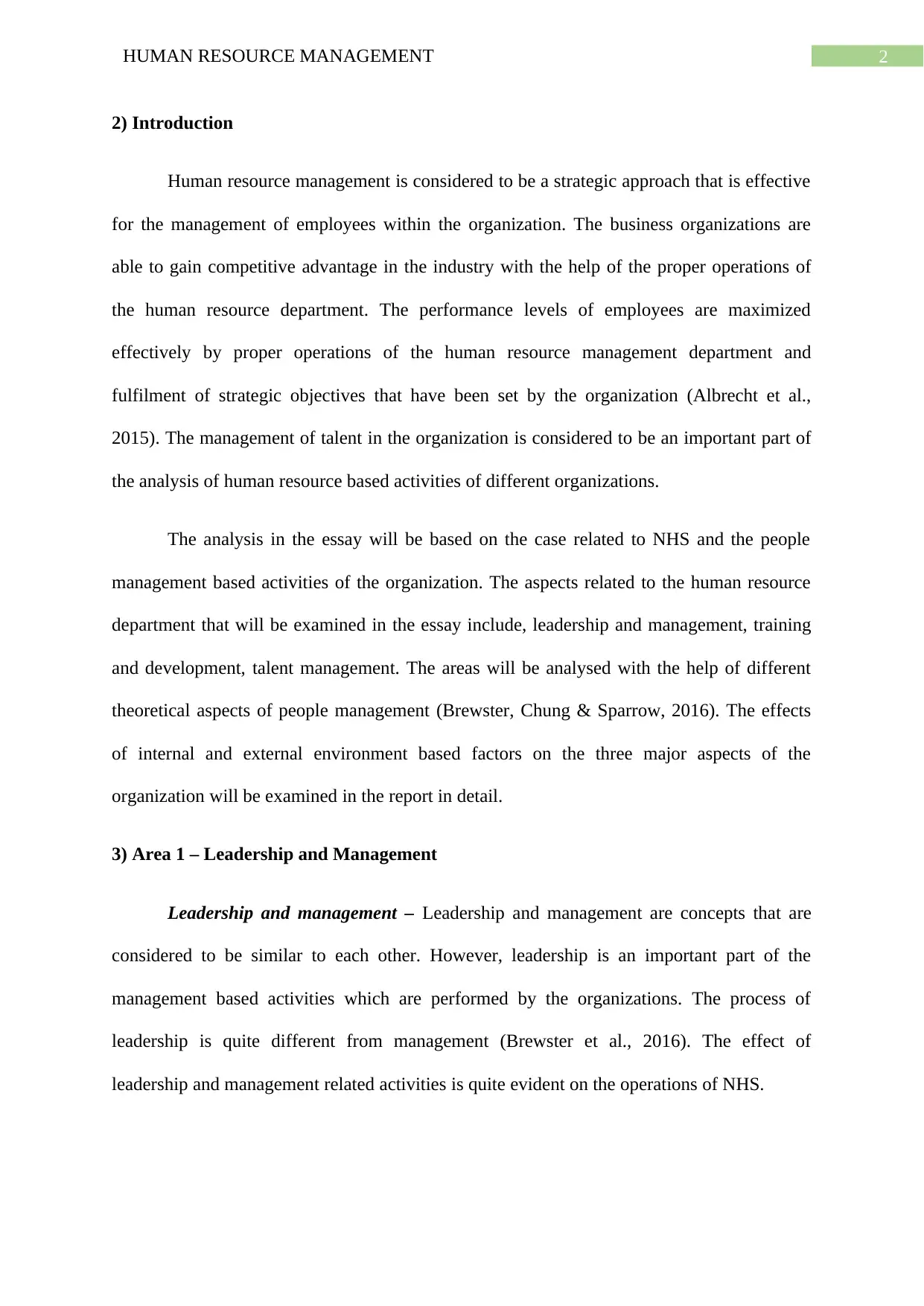
2HUMAN RESOURCE MANAGEMENT
2) Introduction
Human resource management is considered to be a strategic approach that is effective
for the management of employees within the organization. The business organizations are
able to gain competitive advantage in the industry with the help of the proper operations of
the human resource department. The performance levels of employees are maximized
effectively by proper operations of the human resource management department and
fulfilment of strategic objectives that have been set by the organization (Albrecht et al.,
2015). The management of talent in the organization is considered to be an important part of
the analysis of human resource based activities of different organizations.
The analysis in the essay will be based on the case related to NHS and the people
management based activities of the organization. The aspects related to the human resource
department that will be examined in the essay include, leadership and management, training
and development, talent management. The areas will be analysed with the help of different
theoretical aspects of people management (Brewster, Chung & Sparrow, 2016). The effects
of internal and external environment based factors on the three major aspects of the
organization will be examined in the report in detail.
3) Area 1 – Leadership and Management
Leadership and management – Leadership and management are concepts that are
considered to be similar to each other. However, leadership is an important part of the
management based activities which are performed by the organizations. The process of
leadership is quite different from management (Brewster et al., 2016). The effect of
leadership and management related activities is quite evident on the operations of NHS.
2) Introduction
Human resource management is considered to be a strategic approach that is effective
for the management of employees within the organization. The business organizations are
able to gain competitive advantage in the industry with the help of the proper operations of
the human resource department. The performance levels of employees are maximized
effectively by proper operations of the human resource management department and
fulfilment of strategic objectives that have been set by the organization (Albrecht et al.,
2015). The management of talent in the organization is considered to be an important part of
the analysis of human resource based activities of different organizations.
The analysis in the essay will be based on the case related to NHS and the people
management based activities of the organization. The aspects related to the human resource
department that will be examined in the essay include, leadership and management, training
and development, talent management. The areas will be analysed with the help of different
theoretical aspects of people management (Brewster, Chung & Sparrow, 2016). The effects
of internal and external environment based factors on the three major aspects of the
organization will be examined in the report in detail.
3) Area 1 – Leadership and Management
Leadership and management – Leadership and management are concepts that are
considered to be similar to each other. However, leadership is an important part of the
management based activities which are performed by the organizations. The process of
leadership is quite different from management (Brewster et al., 2016). The effect of
leadership and management related activities is quite evident on the operations of NHS.
⊘ This is a preview!⊘
Do you want full access?
Subscribe today to unlock all pages.

Trusted by 1+ million students worldwide
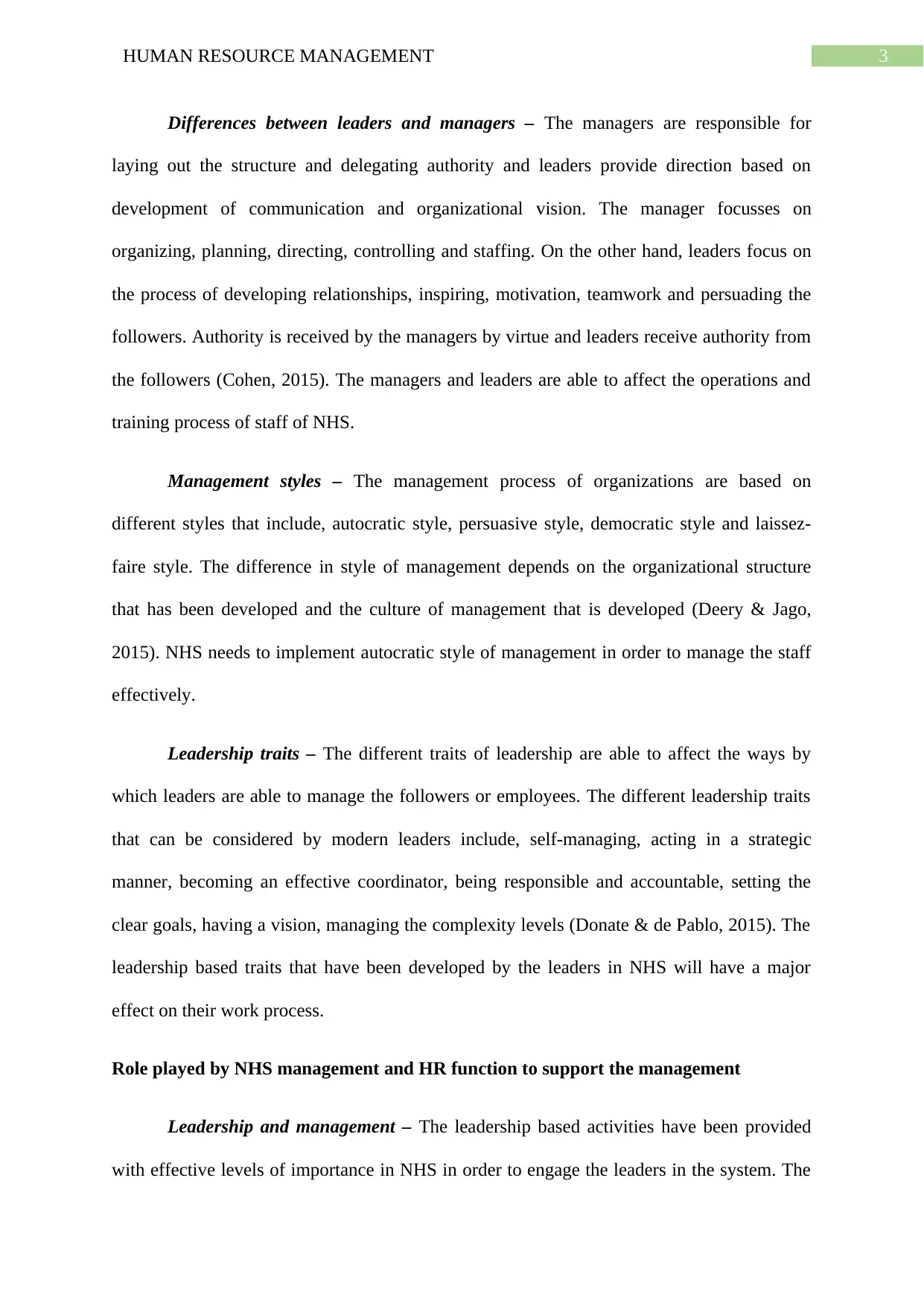
3HUMAN RESOURCE MANAGEMENT
Differences between leaders and managers – The managers are responsible for
laying out the structure and delegating authority and leaders provide direction based on
development of communication and organizational vision. The manager focusses on
organizing, planning, directing, controlling and staffing. On the other hand, leaders focus on
the process of developing relationships, inspiring, motivation, teamwork and persuading the
followers. Authority is received by the managers by virtue and leaders receive authority from
the followers (Cohen, 2015). The managers and leaders are able to affect the operations and
training process of staff of NHS.
Management styles – The management process of organizations are based on
different styles that include, autocratic style, persuasive style, democratic style and laissez-
faire style. The difference in style of management depends on the organizational structure
that has been developed and the culture of management that is developed (Deery & Jago,
2015). NHS needs to implement autocratic style of management in order to manage the staff
effectively.
Leadership traits – The different traits of leadership are able to affect the ways by
which leaders are able to manage the followers or employees. The different leadership traits
that can be considered by modern leaders include, self-managing, acting in a strategic
manner, becoming an effective coordinator, being responsible and accountable, setting the
clear goals, having a vision, managing the complexity levels (Donate & de Pablo, 2015). The
leadership based traits that have been developed by the leaders in NHS will have a major
effect on their work process.
Role played by NHS management and HR function to support the management
Leadership and management – The leadership based activities have been provided
with effective levels of importance in NHS in order to engage the leaders in the system. The
Differences between leaders and managers – The managers are responsible for
laying out the structure and delegating authority and leaders provide direction based on
development of communication and organizational vision. The manager focusses on
organizing, planning, directing, controlling and staffing. On the other hand, leaders focus on
the process of developing relationships, inspiring, motivation, teamwork and persuading the
followers. Authority is received by the managers by virtue and leaders receive authority from
the followers (Cohen, 2015). The managers and leaders are able to affect the operations and
training process of staff of NHS.
Management styles – The management process of organizations are based on
different styles that include, autocratic style, persuasive style, democratic style and laissez-
faire style. The difference in style of management depends on the organizational structure
that has been developed and the culture of management that is developed (Deery & Jago,
2015). NHS needs to implement autocratic style of management in order to manage the staff
effectively.
Leadership traits – The different traits of leadership are able to affect the ways by
which leaders are able to manage the followers or employees. The different leadership traits
that can be considered by modern leaders include, self-managing, acting in a strategic
manner, becoming an effective coordinator, being responsible and accountable, setting the
clear goals, having a vision, managing the complexity levels (Donate & de Pablo, 2015). The
leadership based traits that have been developed by the leaders in NHS will have a major
effect on their work process.
Role played by NHS management and HR function to support the management
Leadership and management – The leadership based activities have been provided
with effective levels of importance in NHS in order to engage the leaders in the system. The
Paraphrase This Document
Need a fresh take? Get an instant paraphrase of this document with our AI Paraphraser
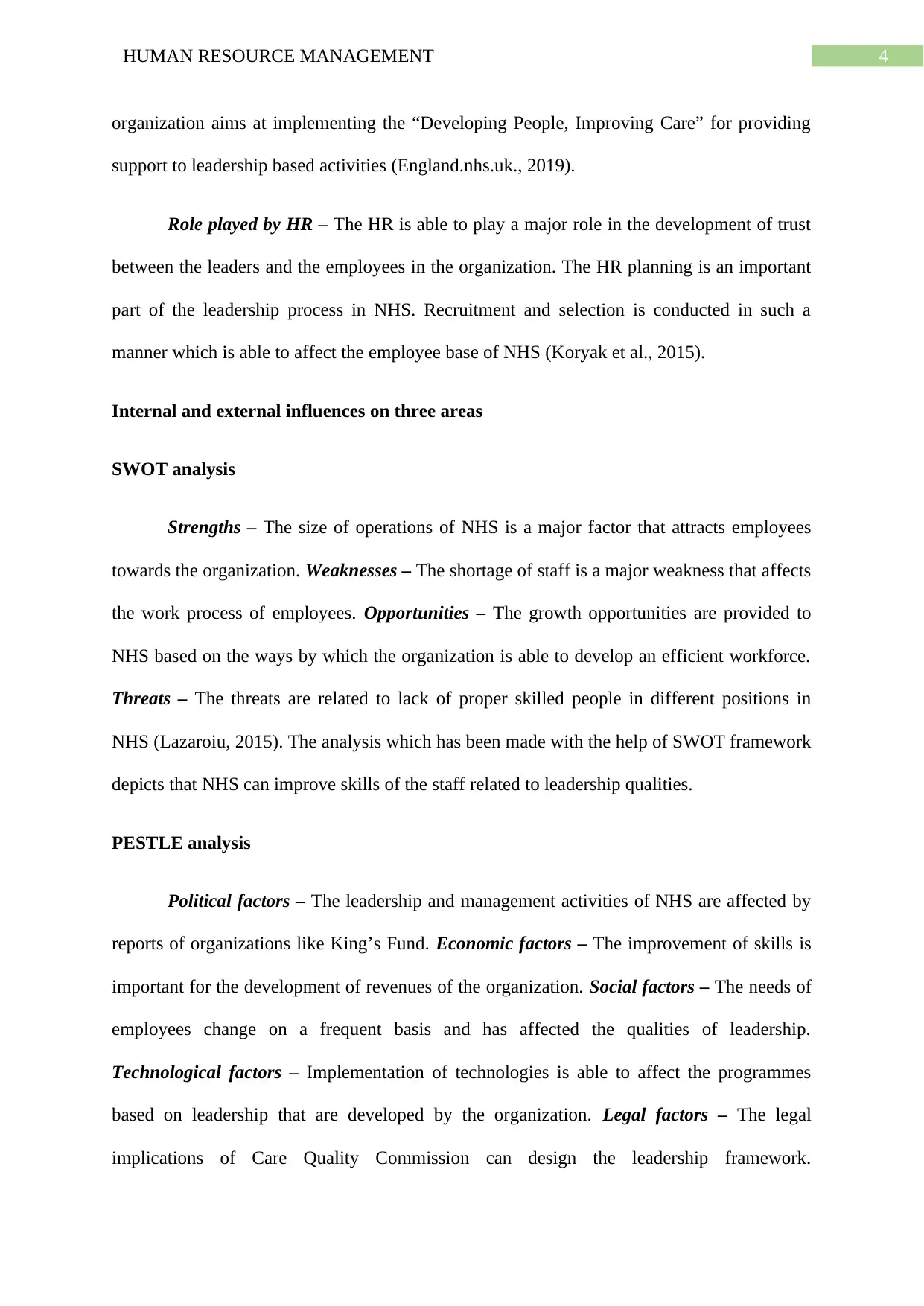
4HUMAN RESOURCE MANAGEMENT
organization aims at implementing the “Developing People, Improving Care” for providing
support to leadership based activities (England.nhs.uk., 2019).
Role played by HR – The HR is able to play a major role in the development of trust
between the leaders and the employees in the organization. The HR planning is an important
part of the leadership process in NHS. Recruitment and selection is conducted in such a
manner which is able to affect the employee base of NHS (Koryak et al., 2015).
Internal and external influences on three areas
SWOT analysis
Strengths – The size of operations of NHS is a major factor that attracts employees
towards the organization. Weaknesses – The shortage of staff is a major weakness that affects
the work process of employees. Opportunities – The growth opportunities are provided to
NHS based on the ways by which the organization is able to develop an efficient workforce.
Threats – The threats are related to lack of proper skilled people in different positions in
NHS (Lazaroiu, 2015). The analysis which has been made with the help of SWOT framework
depicts that NHS can improve skills of the staff related to leadership qualities.
PESTLE analysis
Political factors – The leadership and management activities of NHS are affected by
reports of organizations like King’s Fund. Economic factors – The improvement of skills is
important for the development of revenues of the organization. Social factors – The needs of
employees change on a frequent basis and has affected the qualities of leadership.
Technological factors – Implementation of technologies is able to affect the programmes
based on leadership that are developed by the organization. Legal factors – The legal
implications of Care Quality Commission can design the leadership framework.
organization aims at implementing the “Developing People, Improving Care” for providing
support to leadership based activities (England.nhs.uk., 2019).
Role played by HR – The HR is able to play a major role in the development of trust
between the leaders and the employees in the organization. The HR planning is an important
part of the leadership process in NHS. Recruitment and selection is conducted in such a
manner which is able to affect the employee base of NHS (Koryak et al., 2015).
Internal and external influences on three areas
SWOT analysis
Strengths – The size of operations of NHS is a major factor that attracts employees
towards the organization. Weaknesses – The shortage of staff is a major weakness that affects
the work process of employees. Opportunities – The growth opportunities are provided to
NHS based on the ways by which the organization is able to develop an efficient workforce.
Threats – The threats are related to lack of proper skilled people in different positions in
NHS (Lazaroiu, 2015). The analysis which has been made with the help of SWOT framework
depicts that NHS can improve skills of the staff related to leadership qualities.
PESTLE analysis
Political factors – The leadership and management activities of NHS are affected by
reports of organizations like King’s Fund. Economic factors – The improvement of skills is
important for the development of revenues of the organization. Social factors – The needs of
employees change on a frequent basis and has affected the qualities of leadership.
Technological factors – Implementation of technologies is able to affect the programmes
based on leadership that are developed by the organization. Legal factors – The legal
implications of Care Quality Commission can design the leadership framework.
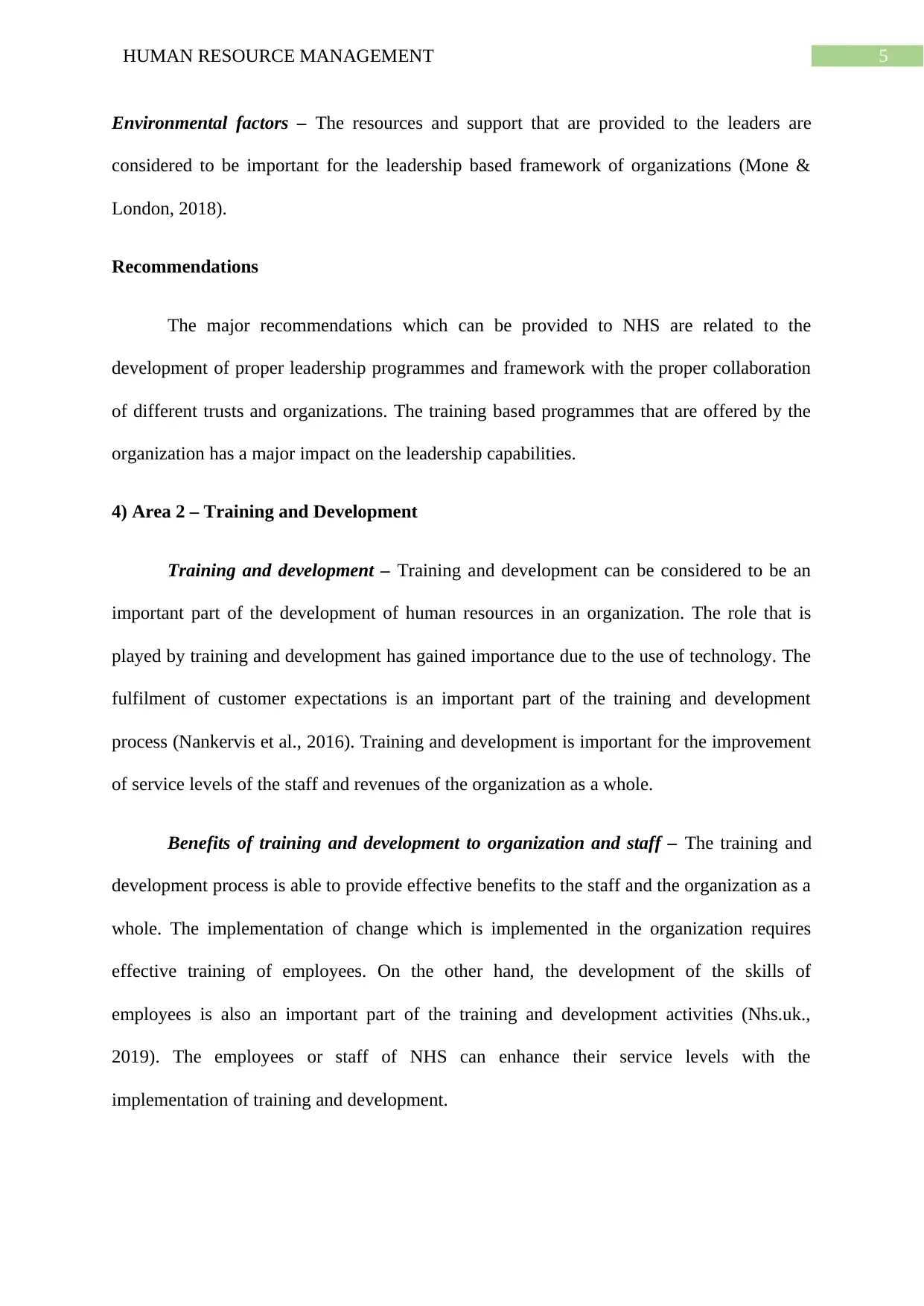
5HUMAN RESOURCE MANAGEMENT
Environmental factors – The resources and support that are provided to the leaders are
considered to be important for the leadership based framework of organizations (Mone &
London, 2018).
Recommendations
The major recommendations which can be provided to NHS are related to the
development of proper leadership programmes and framework with the proper collaboration
of different trusts and organizations. The training based programmes that are offered by the
organization has a major impact on the leadership capabilities.
4) Area 2 – Training and Development
Training and development – Training and development can be considered to be an
important part of the development of human resources in an organization. The role that is
played by training and development has gained importance due to the use of technology. The
fulfilment of customer expectations is an important part of the training and development
process (Nankervis et al., 2016). Training and development is important for the improvement
of service levels of the staff and revenues of the organization as a whole.
Benefits of training and development to organization and staff – The training and
development process is able to provide effective benefits to the staff and the organization as a
whole. The implementation of change which is implemented in the organization requires
effective training of employees. On the other hand, the development of the skills of
employees is also an important part of the training and development activities (Nhs.uk.,
2019). The employees or staff of NHS can enhance their service levels with the
implementation of training and development.
Environmental factors – The resources and support that are provided to the leaders are
considered to be important for the leadership based framework of organizations (Mone &
London, 2018).
Recommendations
The major recommendations which can be provided to NHS are related to the
development of proper leadership programmes and framework with the proper collaboration
of different trusts and organizations. The training based programmes that are offered by the
organization has a major impact on the leadership capabilities.
4) Area 2 – Training and Development
Training and development – Training and development can be considered to be an
important part of the development of human resources in an organization. The role that is
played by training and development has gained importance due to the use of technology. The
fulfilment of customer expectations is an important part of the training and development
process (Nankervis et al., 2016). Training and development is important for the improvement
of service levels of the staff and revenues of the organization as a whole.
Benefits of training and development to organization and staff – The training and
development process is able to provide effective benefits to the staff and the organization as a
whole. The implementation of change which is implemented in the organization requires
effective training of employees. On the other hand, the development of the skills of
employees is also an important part of the training and development activities (Nhs.uk.,
2019). The employees or staff of NHS can enhance their service levels with the
implementation of training and development.
⊘ This is a preview!⊘
Do you want full access?
Subscribe today to unlock all pages.

Trusted by 1+ million students worldwide
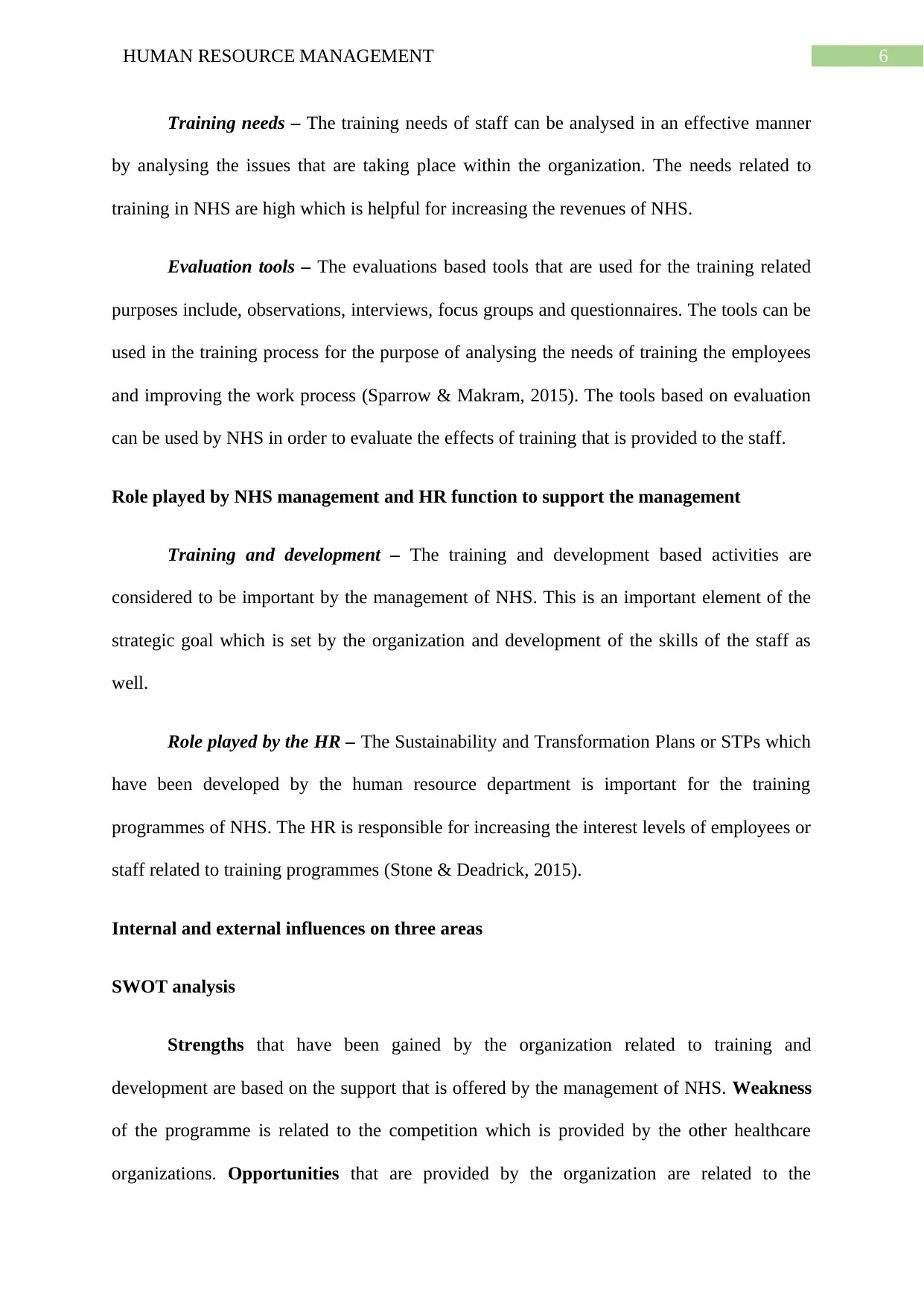
6HUMAN RESOURCE MANAGEMENT
Training needs – The training needs of staff can be analysed in an effective manner
by analysing the issues that are taking place within the organization. The needs related to
training in NHS are high which is helpful for increasing the revenues of NHS.
Evaluation tools – The evaluations based tools that are used for the training related
purposes include, observations, interviews, focus groups and questionnaires. The tools can be
used in the training process for the purpose of analysing the needs of training the employees
and improving the work process (Sparrow & Makram, 2015). The tools based on evaluation
can be used by NHS in order to evaluate the effects of training that is provided to the staff.
Role played by NHS management and HR function to support the management
Training and development – The training and development based activities are
considered to be important by the management of NHS. This is an important element of the
strategic goal which is set by the organization and development of the skills of the staff as
well.
Role played by the HR – The Sustainability and Transformation Plans or STPs which
have been developed by the human resource department is important for the training
programmes of NHS. The HR is responsible for increasing the interest levels of employees or
staff related to training programmes (Stone & Deadrick, 2015).
Internal and external influences on three areas
SWOT analysis
Strengths that have been gained by the organization related to training and
development are based on the support that is offered by the management of NHS. Weakness
of the programme is related to the competition which is provided by the other healthcare
organizations. Opportunities that are provided by the organization are related to the
Training needs – The training needs of staff can be analysed in an effective manner
by analysing the issues that are taking place within the organization. The needs related to
training in NHS are high which is helpful for increasing the revenues of NHS.
Evaluation tools – The evaluations based tools that are used for the training related
purposes include, observations, interviews, focus groups and questionnaires. The tools can be
used in the training process for the purpose of analysing the needs of training the employees
and improving the work process (Sparrow & Makram, 2015). The tools based on evaluation
can be used by NHS in order to evaluate the effects of training that is provided to the staff.
Role played by NHS management and HR function to support the management
Training and development – The training and development based activities are
considered to be important by the management of NHS. This is an important element of the
strategic goal which is set by the organization and development of the skills of the staff as
well.
Role played by the HR – The Sustainability and Transformation Plans or STPs which
have been developed by the human resource department is important for the training
programmes of NHS. The HR is responsible for increasing the interest levels of employees or
staff related to training programmes (Stone & Deadrick, 2015).
Internal and external influences on three areas
SWOT analysis
Strengths that have been gained by the organization related to training and
development are based on the support that is offered by the management of NHS. Weakness
of the programme is related to the competition which is provided by the other healthcare
organizations. Opportunities that are provided by the organization are related to the
Paraphrase This Document
Need a fresh take? Get an instant paraphrase of this document with our AI Paraphraser
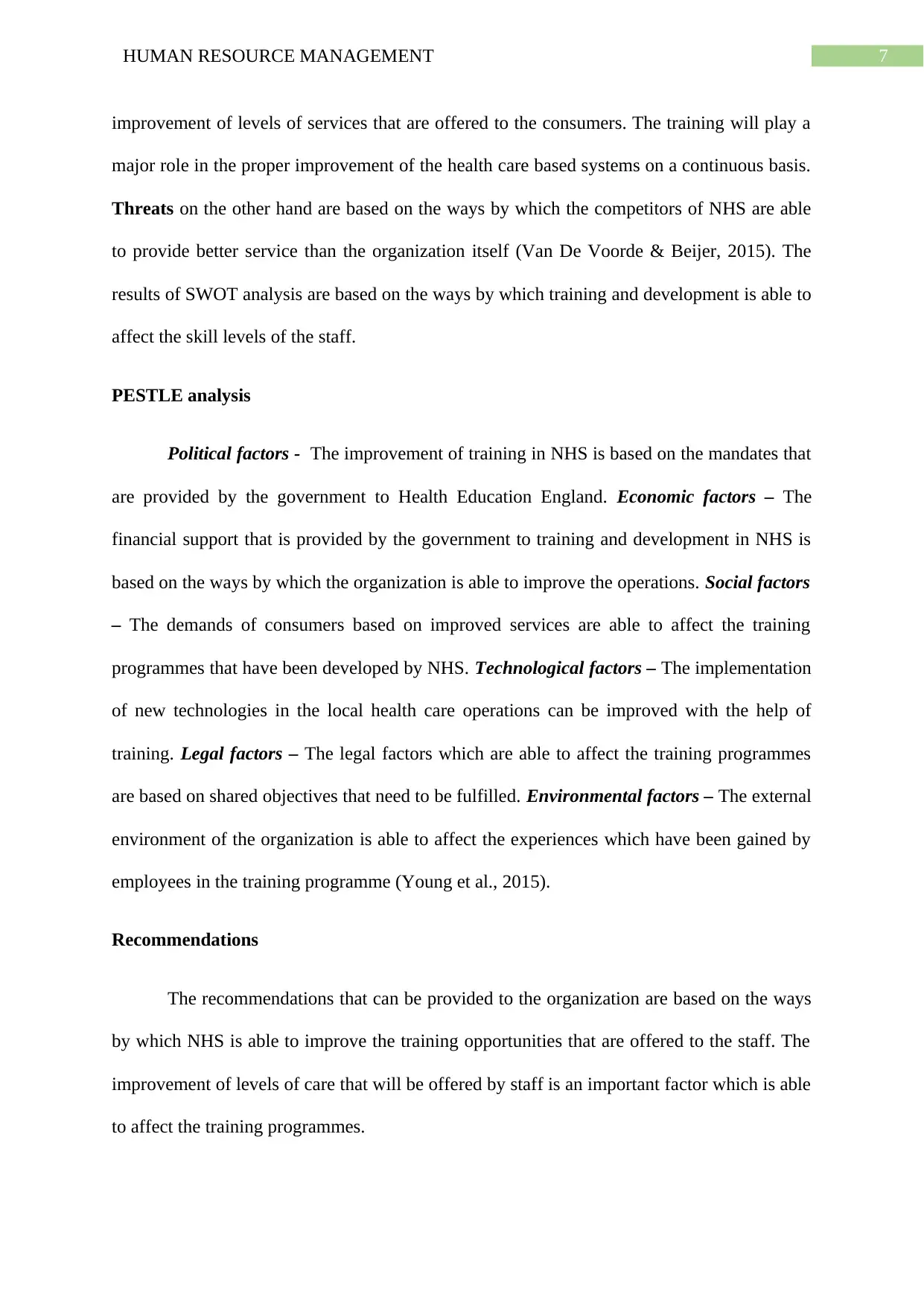
7HUMAN RESOURCE MANAGEMENT
improvement of levels of services that are offered to the consumers. The training will play a
major role in the proper improvement of the health care based systems on a continuous basis.
Threats on the other hand are based on the ways by which the competitors of NHS are able
to provide better service than the organization itself (Van De Voorde & Beijer, 2015). The
results of SWOT analysis are based on the ways by which training and development is able to
affect the skill levels of the staff.
PESTLE analysis
Political factors - The improvement of training in NHS is based on the mandates that
are provided by the government to Health Education England. Economic factors – The
financial support that is provided by the government to training and development in NHS is
based on the ways by which the organization is able to improve the operations. Social factors
– The demands of consumers based on improved services are able to affect the training
programmes that have been developed by NHS. Technological factors – The implementation
of new technologies in the local health care operations can be improved with the help of
training. Legal factors – The legal factors which are able to affect the training programmes
are based on shared objectives that need to be fulfilled. Environmental factors – The external
environment of the organization is able to affect the experiences which have been gained by
employees in the training programme (Young et al., 2015).
Recommendations
The recommendations that can be provided to the organization are based on the ways
by which NHS is able to improve the training opportunities that are offered to the staff. The
improvement of levels of care that will be offered by staff is an important factor which is able
to affect the training programmes.
improvement of levels of services that are offered to the consumers. The training will play a
major role in the proper improvement of the health care based systems on a continuous basis.
Threats on the other hand are based on the ways by which the competitors of NHS are able
to provide better service than the organization itself (Van De Voorde & Beijer, 2015). The
results of SWOT analysis are based on the ways by which training and development is able to
affect the skill levels of the staff.
PESTLE analysis
Political factors - The improvement of training in NHS is based on the mandates that
are provided by the government to Health Education England. Economic factors – The
financial support that is provided by the government to training and development in NHS is
based on the ways by which the organization is able to improve the operations. Social factors
– The demands of consumers based on improved services are able to affect the training
programmes that have been developed by NHS. Technological factors – The implementation
of new technologies in the local health care operations can be improved with the help of
training. Legal factors – The legal factors which are able to affect the training programmes
are based on shared objectives that need to be fulfilled. Environmental factors – The external
environment of the organization is able to affect the experiences which have been gained by
employees in the training programme (Young et al., 2015).
Recommendations
The recommendations that can be provided to the organization are based on the ways
by which NHS is able to improve the training opportunities that are offered to the staff. The
improvement of levels of care that will be offered by staff is an important factor which is able
to affect the training programmes.
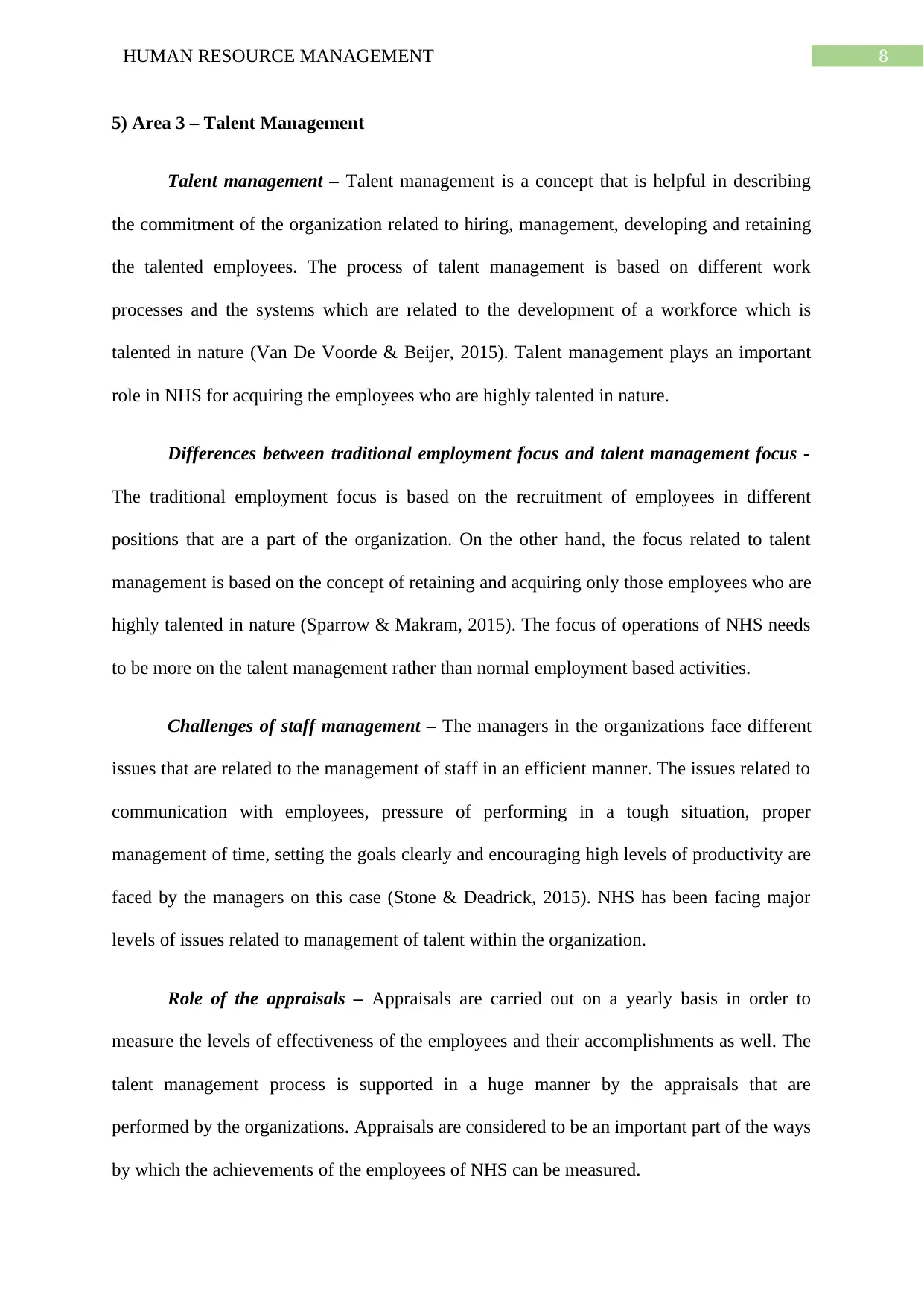
8HUMAN RESOURCE MANAGEMENT
5) Area 3 – Talent Management
Talent management – Talent management is a concept that is helpful in describing
the commitment of the organization related to hiring, management, developing and retaining
the talented employees. The process of talent management is based on different work
processes and the systems which are related to the development of a workforce which is
talented in nature (Van De Voorde & Beijer, 2015). Talent management plays an important
role in NHS for acquiring the employees who are highly talented in nature.
Differences between traditional employment focus and talent management focus -
The traditional employment focus is based on the recruitment of employees in different
positions that are a part of the organization. On the other hand, the focus related to talent
management is based on the concept of retaining and acquiring only those employees who are
highly talented in nature (Sparrow & Makram, 2015). The focus of operations of NHS needs
to be more on the talent management rather than normal employment based activities.
Challenges of staff management – The managers in the organizations face different
issues that are related to the management of staff in an efficient manner. The issues related to
communication with employees, pressure of performing in a tough situation, proper
management of time, setting the goals clearly and encouraging high levels of productivity are
faced by the managers on this case (Stone & Deadrick, 2015). NHS has been facing major
levels of issues related to management of talent within the organization.
Role of the appraisals – Appraisals are carried out on a yearly basis in order to
measure the levels of effectiveness of the employees and their accomplishments as well. The
talent management process is supported in a huge manner by the appraisals that are
performed by the organizations. Appraisals are considered to be an important part of the ways
by which the achievements of the employees of NHS can be measured.
5) Area 3 – Talent Management
Talent management – Talent management is a concept that is helpful in describing
the commitment of the organization related to hiring, management, developing and retaining
the talented employees. The process of talent management is based on different work
processes and the systems which are related to the development of a workforce which is
talented in nature (Van De Voorde & Beijer, 2015). Talent management plays an important
role in NHS for acquiring the employees who are highly talented in nature.
Differences between traditional employment focus and talent management focus -
The traditional employment focus is based on the recruitment of employees in different
positions that are a part of the organization. On the other hand, the focus related to talent
management is based on the concept of retaining and acquiring only those employees who are
highly talented in nature (Sparrow & Makram, 2015). The focus of operations of NHS needs
to be more on the talent management rather than normal employment based activities.
Challenges of staff management – The managers in the organizations face different
issues that are related to the management of staff in an efficient manner. The issues related to
communication with employees, pressure of performing in a tough situation, proper
management of time, setting the goals clearly and encouraging high levels of productivity are
faced by the managers on this case (Stone & Deadrick, 2015). NHS has been facing major
levels of issues related to management of talent within the organization.
Role of the appraisals – Appraisals are carried out on a yearly basis in order to
measure the levels of effectiveness of the employees and their accomplishments as well. The
talent management process is supported in a huge manner by the appraisals that are
performed by the organizations. Appraisals are considered to be an important part of the ways
by which the achievements of the employees of NHS can be measured.
⊘ This is a preview!⊘
Do you want full access?
Subscribe today to unlock all pages.

Trusted by 1+ million students worldwide
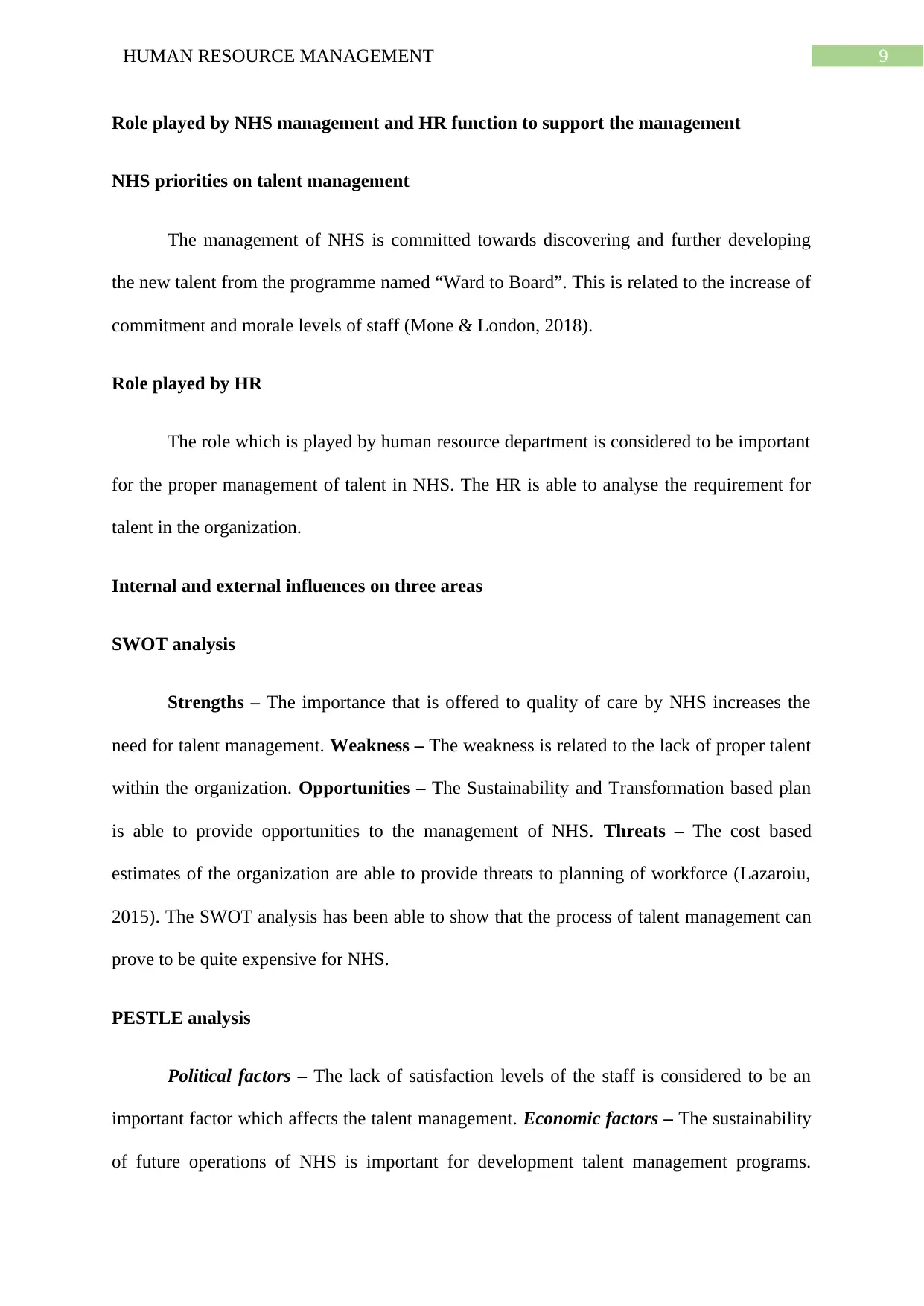
9HUMAN RESOURCE MANAGEMENT
Role played by NHS management and HR function to support the management
NHS priorities on talent management
The management of NHS is committed towards discovering and further developing
the new talent from the programme named “Ward to Board”. This is related to the increase of
commitment and morale levels of staff (Mone & London, 2018).
Role played by HR
The role which is played by human resource department is considered to be important
for the proper management of talent in NHS. The HR is able to analyse the requirement for
talent in the organization.
Internal and external influences on three areas
SWOT analysis
Strengths – The importance that is offered to quality of care by NHS increases the
need for talent management. Weakness – The weakness is related to the lack of proper talent
within the organization. Opportunities – The Sustainability and Transformation based plan
is able to provide opportunities to the management of NHS. Threats – The cost based
estimates of the organization are able to provide threats to planning of workforce (Lazaroiu,
2015). The SWOT analysis has been able to show that the process of talent management can
prove to be quite expensive for NHS.
PESTLE analysis
Political factors – The lack of satisfaction levels of the staff is considered to be an
important factor which affects the talent management. Economic factors – The sustainability
of future operations of NHS is important for development talent management programs.
Role played by NHS management and HR function to support the management
NHS priorities on talent management
The management of NHS is committed towards discovering and further developing
the new talent from the programme named “Ward to Board”. This is related to the increase of
commitment and morale levels of staff (Mone & London, 2018).
Role played by HR
The role which is played by human resource department is considered to be important
for the proper management of talent in NHS. The HR is able to analyse the requirement for
talent in the organization.
Internal and external influences on three areas
SWOT analysis
Strengths – The importance that is offered to quality of care by NHS increases the
need for talent management. Weakness – The weakness is related to the lack of proper talent
within the organization. Opportunities – The Sustainability and Transformation based plan
is able to provide opportunities to the management of NHS. Threats – The cost based
estimates of the organization are able to provide threats to planning of workforce (Lazaroiu,
2015). The SWOT analysis has been able to show that the process of talent management can
prove to be quite expensive for NHS.
PESTLE analysis
Political factors – The lack of satisfaction levels of the staff is considered to be an
important factor which affects the talent management. Economic factors – The sustainability
of future operations of NHS is important for development talent management programs.
Paraphrase This Document
Need a fresh take? Get an instant paraphrase of this document with our AI Paraphraser
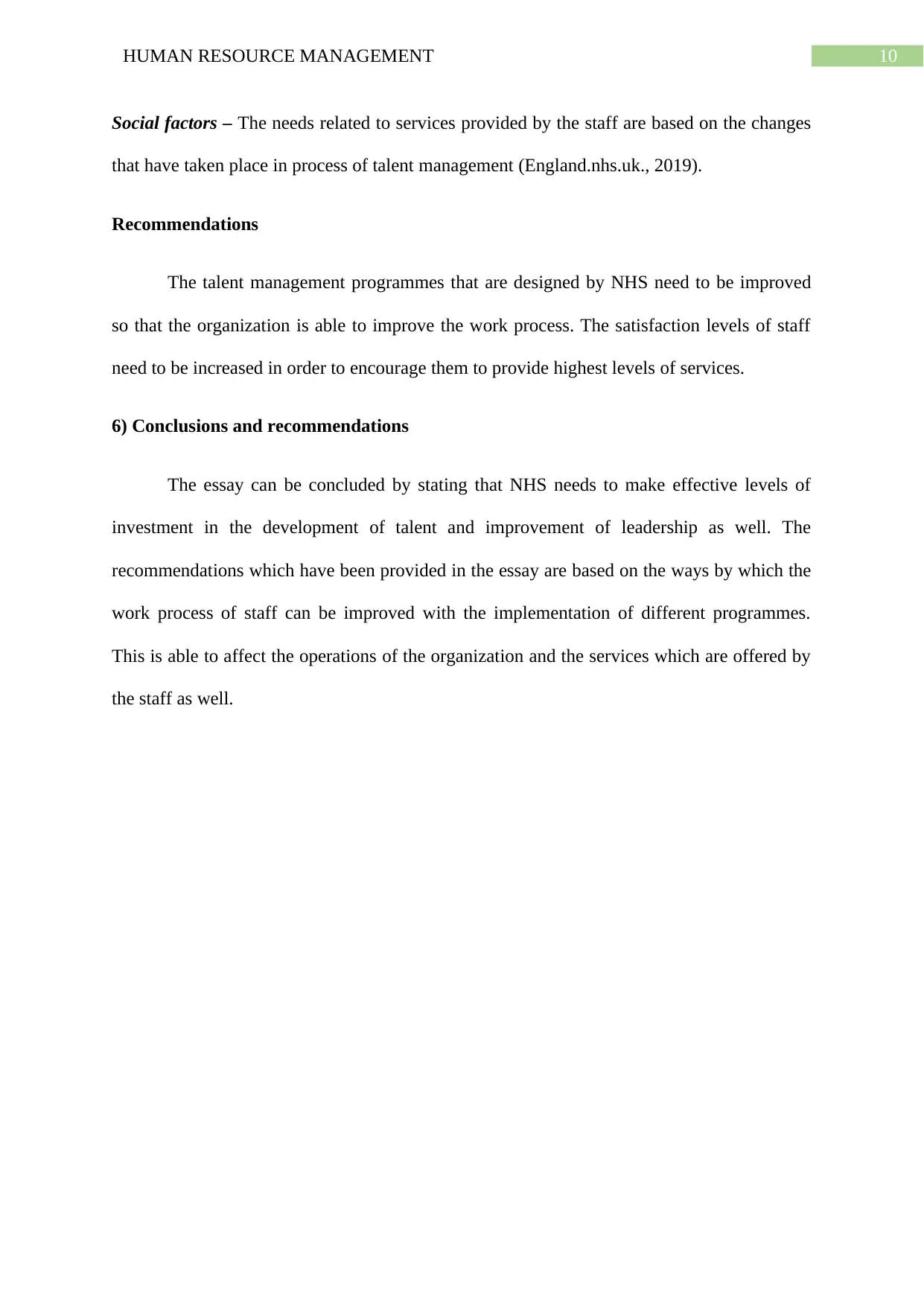
10HUMAN RESOURCE MANAGEMENT
Social factors – The needs related to services provided by the staff are based on the changes
that have taken place in process of talent management (England.nhs.uk., 2019).
Recommendations
The talent management programmes that are designed by NHS need to be improved
so that the organization is able to improve the work process. The satisfaction levels of staff
need to be increased in order to encourage them to provide highest levels of services.
6) Conclusions and recommendations
The essay can be concluded by stating that NHS needs to make effective levels of
investment in the development of talent and improvement of leadership as well. The
recommendations which have been provided in the essay are based on the ways by which the
work process of staff can be improved with the implementation of different programmes.
This is able to affect the operations of the organization and the services which are offered by
the staff as well.
Social factors – The needs related to services provided by the staff are based on the changes
that have taken place in process of talent management (England.nhs.uk., 2019).
Recommendations
The talent management programmes that are designed by NHS need to be improved
so that the organization is able to improve the work process. The satisfaction levels of staff
need to be increased in order to encourage them to provide highest levels of services.
6) Conclusions and recommendations
The essay can be concluded by stating that NHS needs to make effective levels of
investment in the development of talent and improvement of leadership as well. The
recommendations which have been provided in the essay are based on the ways by which the
work process of staff can be improved with the implementation of different programmes.
This is able to affect the operations of the organization and the services which are offered by
the staff as well.
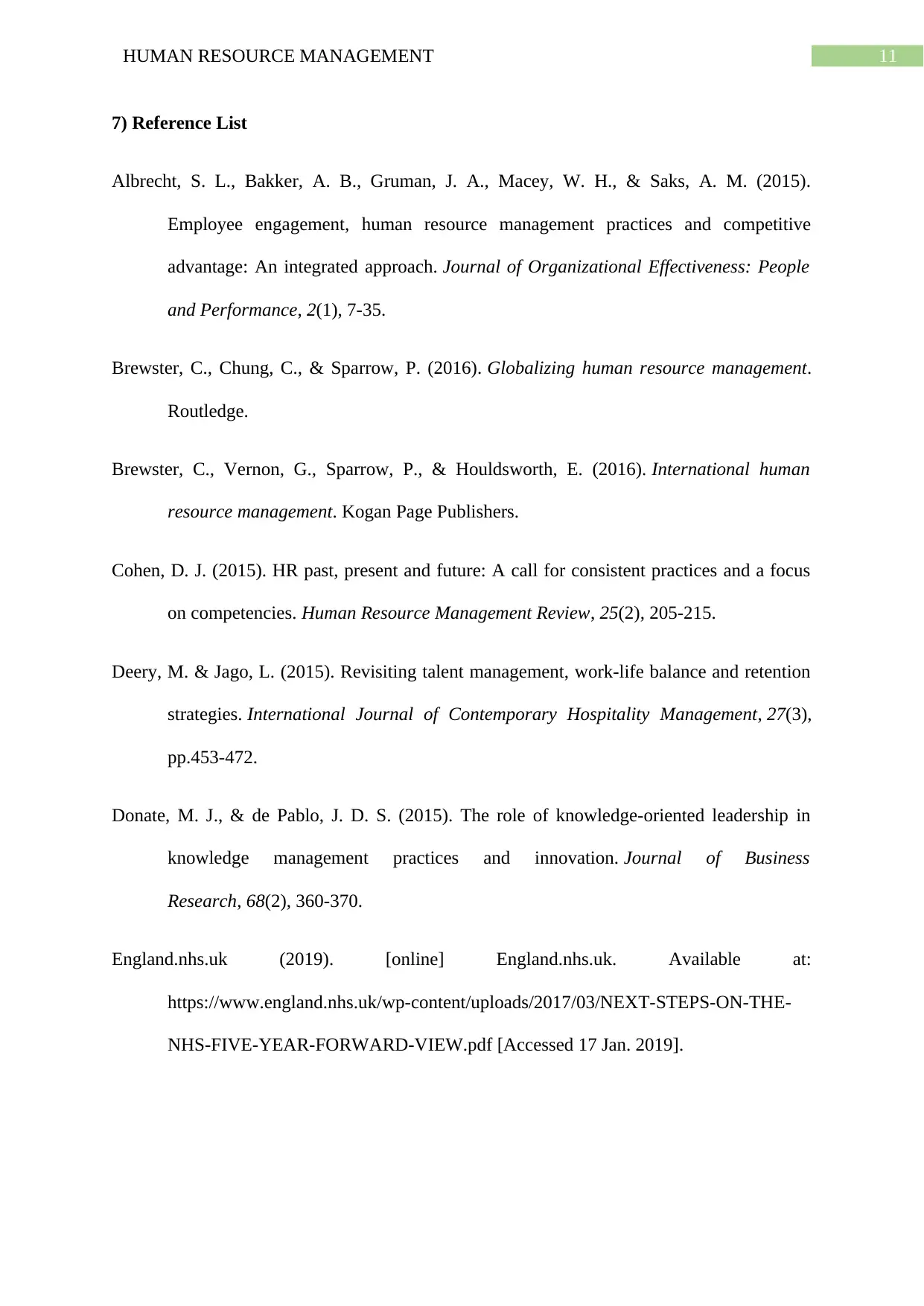
11HUMAN RESOURCE MANAGEMENT
7) Reference List
Albrecht, S. L., Bakker, A. B., Gruman, J. A., Macey, W. H., & Saks, A. M. (2015).
Employee engagement, human resource management practices and competitive
advantage: An integrated approach. Journal of Organizational Effectiveness: People
and Performance, 2(1), 7-35.
Brewster, C., Chung, C., & Sparrow, P. (2016). Globalizing human resource management.
Routledge.
Brewster, C., Vernon, G., Sparrow, P., & Houldsworth, E. (2016). International human
resource management. Kogan Page Publishers.
Cohen, D. J. (2015). HR past, present and future: A call for consistent practices and a focus
on competencies. Human Resource Management Review, 25(2), 205-215.
Deery, M. & Jago, L. (2015). Revisiting talent management, work-life balance and retention
strategies. International Journal of Contemporary Hospitality Management, 27(3),
pp.453-472.
Donate, M. J., & de Pablo, J. D. S. (2015). The role of knowledge-oriented leadership in
knowledge management practices and innovation. Journal of Business
Research, 68(2), 360-370.
England.nhs.uk (2019). [online] England.nhs.uk. Available at:
https://www.england.nhs.uk/wp-content/uploads/2017/03/NEXT-STEPS-ON-THE-
NHS-FIVE-YEAR-FORWARD-VIEW.pdf [Accessed 17 Jan. 2019].
7) Reference List
Albrecht, S. L., Bakker, A. B., Gruman, J. A., Macey, W. H., & Saks, A. M. (2015).
Employee engagement, human resource management practices and competitive
advantage: An integrated approach. Journal of Organizational Effectiveness: People
and Performance, 2(1), 7-35.
Brewster, C., Chung, C., & Sparrow, P. (2016). Globalizing human resource management.
Routledge.
Brewster, C., Vernon, G., Sparrow, P., & Houldsworth, E. (2016). International human
resource management. Kogan Page Publishers.
Cohen, D. J. (2015). HR past, present and future: A call for consistent practices and a focus
on competencies. Human Resource Management Review, 25(2), 205-215.
Deery, M. & Jago, L. (2015). Revisiting talent management, work-life balance and retention
strategies. International Journal of Contemporary Hospitality Management, 27(3),
pp.453-472.
Donate, M. J., & de Pablo, J. D. S. (2015). The role of knowledge-oriented leadership in
knowledge management practices and innovation. Journal of Business
Research, 68(2), 360-370.
England.nhs.uk (2019). [online] England.nhs.uk. Available at:
https://www.england.nhs.uk/wp-content/uploads/2017/03/NEXT-STEPS-ON-THE-
NHS-FIVE-YEAR-FORWARD-VIEW.pdf [Accessed 17 Jan. 2019].
⊘ This is a preview!⊘
Do you want full access?
Subscribe today to unlock all pages.

Trusted by 1+ million students worldwide
1 out of 14
Related Documents
Your All-in-One AI-Powered Toolkit for Academic Success.
+13062052269
info@desklib.com
Available 24*7 on WhatsApp / Email
![[object Object]](/_next/static/media/star-bottom.7253800d.svg)
Unlock your academic potential
Copyright © 2020–2025 A2Z Services. All Rights Reserved. Developed and managed by ZUCOL.




